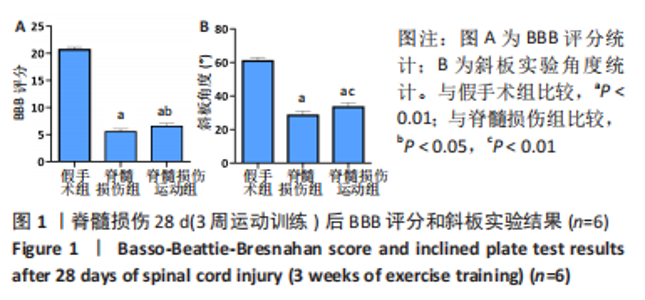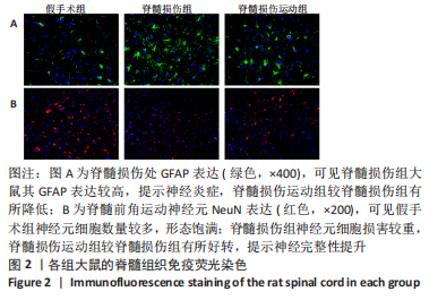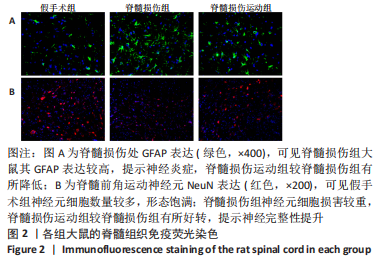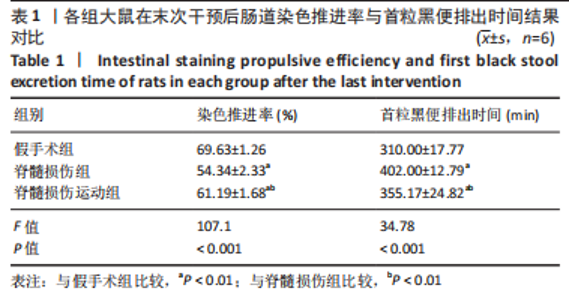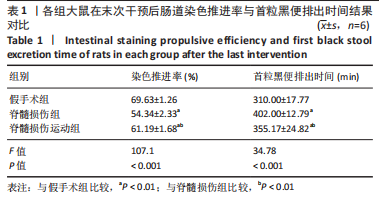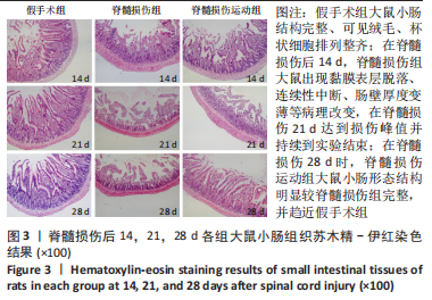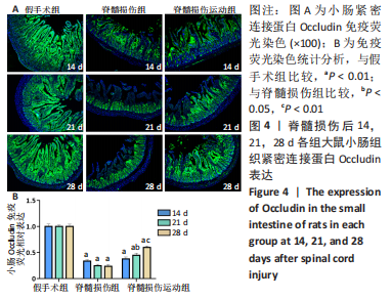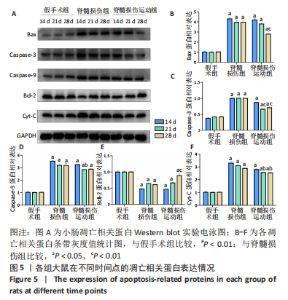Chinese Journal of Tissue Engineering Research ›› 2023, Vol. 27 ›› Issue (32): 5178-5183.doi: 10.12307/2023.846
Previous Articles Next Articles
Treadmill training promotes recovery of small intestine function through inhibition of apoptosis in rats with spinal cord injury
Ouyang shuai1, Wang Xianbin1, 2, Zhang Qian2, Chen Yuan2, Deng Luoyi2, Wang Jia1, Hu Shouxing1, Pan Xiao1, Wu Shuang1, 2
- 1Guizhou Medical University, Guiyang 550000, Guizhou Province, China; 2Department of Rehabilitation Medicine, Affiliated Hospital of Guizhou Medical University, Guiyang 550000, Guizhou Province, China
-
Received:2022-10-21Accepted:2022-11-30Online:2023-11-18Published:2023-03-23 -
Contact:Wu Shuang, MD, Professor, Chief physician, Department of Rehabilitation Medicine, Affiliated Hospital of Guizhou Medical University, Guiyang 550000, Guizhou Province, China -
About author:Ouyang Shuai, Master candidate, Guizhou Medical University, Guiyang 550000, Guizhou Province, China -
Supported by:National Natural Science Foundation of China (Regional Program), Nos. 82060419 and 82260452 (both to WS); Guizhou Provincial Science and Technology Project, No. ZK[2022] key 045 (to WS); Guizhou Provincial Science and Technology Project, No. ZK[2022] general 438 (to WXB); The Doctoral Research Foundation of the Affiliated Hospital of Guizhou Medical University, No. gyfybsky-2021-5 (to WS); Guizhou Provincial Health Commission Foundation, No. gzwkj2022-030 (to WXB)
CLC Number:
Cite this article
Ouyang shuai, Wang Xianbin, Zhang Qian, Chen Yuan, Deng Luoyi, Wang Jia, Hu Shouxing, Pan Xiao, Wu Shuang. Treadmill training promotes recovery of small intestine function through inhibition of apoptosis in rats with spinal cord injury[J]. Chinese Journal of Tissue Engineering Research, 2023, 27(32): 5178-5183.
share this article
Add to citation manager EndNote|Reference Manager|ProCite|BibTeX|RefWorks
| [1] SIMPSON LA, ENG JJ, HSIEH JT, et al. The health and life priorities of individuals with spinal cord injury: a systematic review. J Neurotrauma. 2012;29(8):1548-1555. [2] ANDERSON KD. Targeting recovery: priorities of the spinal cord-injured population. J Neurotrauma. 2004;21(10):1371-1383. [3] EBERT E. Gastrointestinal involvement in spinal cord injury: a clinical perspective. J Gastrointestin Liver Dis. 2012;21(1):75-82. [4] PARKMAN HP. Scintigraphy for evaluation of patients for GI motility disorders--the referring physician’s perspective. Semin Nucl Med. 2012; 42(2):76-78. [5] SARNELLI G, D’ALESSANDRO A, PESCE M, et al. Genetic contribution to motility disorders of the upper gastrointestinal tract. World J Gastrointest Pathophysiol. 2013;4(4):65-73. [6] JING Y, YU Y, BAI F, et al. Effect of fecal microbiota transplantation on neurological restoration in a spinal cord injury mouse model: involvement of brain-gut axis. Microbiome. 2021;9(1):59. [7] HEINEMANN U, SCHUETZ A. Structural Features of Tight-Junction Proteins. Int J Mol Sci. 2019;20(23):6020. [8] EVANS CC, LEPARD KJ, KWAK JW, et al. Exercise prevents weight gain and alters the gut microbiota in a mouse model of high fat diet-induced obesity. PloS one. 2014;9(3):e92193. [9] CHOI J, EUM S, RAMPERSAUD E, et al. Exercise attenuates PCB-induced changes in the mouse gut microbiome. Environ Health Perspect. 2013; 121(6):725-730. [10] PETRIZ BA, CASTRO AP, ALMEIDA JA, et al. Exercise induction of gut microbiota modifications in obese, non-obese and hypertensive rats. BMC Genomics. 2014;15(1):511. [11] CLARKE SF, MURPHY EF, O’SULLIVAN O, et al. Exercise and associated dietary extremes impact on gut microbial diversity. Gut. 2014;63(12): 1913-1920. [12] WANG H, LIU N, ZHANG Y, et al. Treadmill training induced lumbar motoneuron dendritic plasticity and behavior recovery in adult rats after a thoracic contusive spinal cord injury. Exp Neurol. 2015;271:368-378. [13] WARD PJ, HERRITY AN, HARKEMA SJ, et al. Training-Induced Functional Gains following SCI. J Neural plasticity. 2016;2016:4307694. [14] LAMBERT GP, BROUSSARD LJ, MASON BL, et al. Gastrointestinal permeability during exercise: effects of aspirin and energy-containing beverages. J Appl Physiol. 2001;90(6):2075-2080. [15] SHAO C, LI Y, CHEN J, et al. Physical Exercise Repairs Obstructive Jaundice-Induced Damage to Intestinal Mucosal Barrier Function via H2S-Mediated Regulation of the HMGB1/Toll Like Receptors 4/Nuclear Factor Kappa B Pathway. Front Physiol. 2021;12:732780. [16] VAN NIEUWENHOVEN MA, BROUNS F, BRUMMER RJ. Gastrointestinal profile of symptomatic athletes at rest and during physical exercise. Eur J Appl Physiol. 2004;91(4):429-434. [17] KIM JY, CHOI GS, CHO YW, et al. Attenuation of spinal cord injury-induced astroglial and microglial activation by repetitive transcranial magnetic stimulation in rats. J Korean Med Sci. 2013;28(2):295-299. [18] CHOI DC, LEE JY, LIM EJ, et al. Inhibition of ROS-induced p38MAPK and ERK activation in microglia by acupuncture relieves neuropathic pain after spinal cord injury in rats. Exp Neurol. 2012;236(2):268-282. [19] TATE DG, FORCHHEIMER M, RODRIGUEZ G, et al. Risk Factors Associated With Neurogenic Bowel Complications and Dysfunction in Spinal Cord Injury. Arch Phys Med Rehabil. 2016;97(10):1679-1686. [20] 尚云龙,李一帆,宁云峰,等.大鼠脊髓损伤模型的解剖学参考定位[J].解剖学研究,2013,35(6):412-414+481. [21] WU Q, CAO Y, DONG C, et al. Neuromuscular interaction is required for neurotrophins-mediated locomotor recovery following treadmill training in rat spinal cord injury. PeerJ. 2016;4:e2025. [22] KIM YM, JIN JJ, LEE SJ, et al. Treadmill exercise with bone marrow stromal cells transplantation facilitates neuroprotective effect through BDNF-ERK1/2 pathway in spinal cord injury rats. J Exerc Rehabil. 2018; 14(3):335-340. [23] CHIO CC, LIN JW, CHANG MW, et al. Therapeutic evaluation of etanercept in a model of traumatic brain injury. J Neurochem. 2010;115(4):921-929. [24] RIVLIN AS, TATOR CH. Objective clinical assessment of motor function after experimental spinal cord injury in the rat. J Neurosurg. 1977;47(4): 577-581. [25] LIU CW, HUANG CC, YANG YH, et al. Relationship between neurogenic bowel dysfunction and health-related quality of life in persons with spinal cord injury. J Rehabil Med. 2009;41(1):35-40. [26] PREZIOSI G, RAPTIS DA, RAEBURN A, et al. Autonomic rectal dysfunction in patients with multiple sclerosis and bowel symptoms is secondary to spinal cord disease. Dis Colon Rectum. 2014;57(4):514-521. [27] 逯晓蕾,李建军,杜良杰,等.脊髓损伤后肠道功能的变化[J].中国康复理论与实践,2010,16(8):758-760. [28] PETERSEN AM, PEDERSEN BK. The anti-inflammatory effect of exercise. J Appl Physiol. 2005;98(4):1154-1162. [29] CARLESSI A, BORBA L, ZUGNO A, et al. Gut microbiota-brain axis in depression: The role of neuroinflammation. Eur J Neurosci. 2021;53(1): 222-235. [30] 王晨宇,寇冠,王治坤,等.有氧运动对实验性结肠炎小鼠氧化应激、炎症反应及细胞凋亡的影响[J].中华物理医学与康复杂志, 2021,43(4):301-305. [31] ZHANG JD, LIU J, ZHU SW, et al. Berberine alleviates visceral hypersensitivity in rats by altering gut microbiome and suppressing spinal microglial activation. Acta Pharmacol Sin. 2021;42(11):1821-1833. [32] SCHMIDT EKA, TORRES-ESPIN A, RAPOSO PJF, et al. Fecal transplant prevents gut dysbiosis and anxiety-like behaviour after spinal cord injury in rats. PloS One. 2020;15(1):e0226128. [33] 梁家琪,刘恒旭,阳金鑫,等.运动与肠道菌健康效益的关系[J].中国组织工程研究,2023,27(8):1292-1299. [34] LI X, MAO M, ZHANG Y, et al. Succinate Modulates Intestinal Barrier Function and Inflammation Response in Pigs. Biomolecules. 2019;9(9):486. [35] CHELAKKOT C, GHIM J, RYU SH. Mechanisms regulating intestinal barrier integrity and its pathological implications. Exp Mol Med. 2018; 50(8):1-9. [36] KATSANOS KH, PAPADAKIS KA. Inflammatory Bowel Disease: Updates on Molecular Targets for Biologics. Gut Liver. 2017;11(4):455-463. [37] HUO J, XU S, LAM KP. FAIM: An Antagonist of Fas-Killing and Beyond. Cells. 2019;8(6):541. [38] LIU F, WANG X, GENG H, et al. Interferon-γ inhibits sirtuin 6 gene expression in intestinalepithelial cells through a microRNA-92b-dependent mechanism. Am J Physiol Cell Physiol. 2020;318(4): C732-C739. [39] BECKER C, WATSON AJ, NEURATH MF. Complex roles of caspases in the pathogenesis of inflammatory bowel disease. Gastroenterology. 2013; 144(2):283-293. [40] FRIEDRICH M, POHIN M, POWRIE F. Cytokine Networks in the Pathophysiology of Inflammatory Bowel Disease. Immunity. 2019;50(4): 992-1006. |
| [1] | Fang Xingyan, Tian Zhenli, Zhao Zheyi, Wen Ping, Xie Tingting. Effects of sodium arsenite on human umbilical vein endothelial cell injury and sphingosine kinases 1/sphingosine 1-phosphate signaling axis [J]. Chinese Journal of Tissue Engineering Research, 2023, 27(在线): 1-7. |
| [2] | Guo Shuhui, Yang Ye, Jiang Yangyang, Xu Jianwen. Screening and validation of neurogenic bladder miRNA-mRNA regulatory network [J]. Chinese Journal of Tissue Engineering Research, 2023, 27(在线): 1-8. |
| [3] | Huang Linke, Wei Linhua, Jiang Jie, Liu Qian, Chen Weiwei. Effects of estrogen combined with treadmill exercise on bone mass and articular cartilage in ovariectomized mice [J]. Chinese Journal of Tissue Engineering Research, 2023, 27(8): 1166-1171. |
| [4] | Yang Jiujie, Li Zhi, Wang Shujie, Tian Ye, Zhao Wei. Intraoperative neurophysiological monitoring of functional changes following durotomy with decompression for acute spinal cord injury [J]. Chinese Journal of Tissue Engineering Research, 2023, 27(8): 1232-1236. |
| [5] | Nie Chenchen, Su Kaiqi, Gao Jing, Fan Yongfu, Ruan Xiaodi, Yuan Jie, Duan Zhaoyuan, Feng Xiaodong. The regulatory role of circular RNAs in cerebral ischemia-reperfusion injury [J]. Chinese Journal of Tissue Engineering Research, 2023, 27(8): 1286-1291. |
| [6] | Cui Lianxu, Jiang Wenkang, Lu Dahong, Xu Junrong, Liu Xiaocui, Wang Bingyun. Clinical-grade human umbilical cord mesenchymal stem cells affect the improvement of neurological function in rats with traumatic brain injury [J]. Chinese Journal of Tissue Engineering Research, 2023, 27(6): 835-839. |
| [7] | Li Qicheng, Deng Jin, Fu Xiaoyang, Han Na. Effects of bone marrow mesenchymal stem cells-derived exosomes on hypoxia-treated myoblasts [J]. Chinese Journal of Tissue Engineering Research, 2023, 27(6): 853-859. |
| [8] | Hao Liufang, Duan Hongmei, Wang Zijue, Hao Fei, Hao Peng, Zhao Wen, Gao Yudan, Yang Zhaoyang, Li Xiaoguang. Spatiotemporal dynamic changes of ependymal cells after spinal cord injury in transgenic mice [J]. Chinese Journal of Tissue Engineering Research, 2023, 27(6): 883-889. |
| [9] | Li Xiaoyin, Yang Xiaoqing, Chen Shulian, Li Zhengchao, Wang Ziqi, Song Zhen, Zhu Daren, Chen Xuyi. Collagen/silk fibroin scaffold combined with neural stem cells in the treatment of traumatic spinal cord injury [J]. Chinese Journal of Tissue Engineering Research, 2023, 27(6): 890-896. |
| [10] | Zhang Qijian, Xu Ximing. Acquisition and application of ectodermal mesenchymal stem cells [J]. Chinese Journal of Tissue Engineering Research, 2023, 27(6): 928-934. |
| [11] | Zhang Qing, Gao Chunlan, Yu Feifei, Zhang Zhenghao, Ma Fang, Gao Yuan, Li Guizhong, Jiang Yideng, Ma Shengchao. Ephrin A receptor 2 DNA methylation increases in pancreatic beta cell apoptosis induced by homocysteine [J]. Chinese Journal of Tissue Engineering Research, 2023, 27(5): 714-719. |
| [12] | Li Long, Li Guangdi, Shi Hao, Deng Keqi. Circular RNA as a competing endogenous RNA is involved in the regulation of osteoarthritis [J]. Chinese Journal of Tissue Engineering Research, 2023, 27(5): 751-757. |
| [13] | Li Zhichao, Tan Guoqing, Su Hui, Xu Zhanwang, Xue Haipeng. Regulatory role of non-coding RNAs as potential therapeutic targets in spinal cord injury [J]. Chinese Journal of Tissue Engineering Research, 2023, 27(5): 758-764. |
| [14] | Zhao Siqi, Du Juan, Qu Haifeng, Li Jianmin, Zhang Yuxin, Liu Junjie. Effects of enriched environment combined with melatonin on learning and memory function and brain neuron apoptosis in SAMP8 mice [J]. Chinese Journal of Tissue Engineering Research, 2023, 27(5): 701-706. |
| [15] | Li Yujiao, Su Kunxia. High-intensity endurance exercise influences browning of white adipose tissue in a mouse model of high-fat diet induced obesity [J]. Chinese Journal of Tissue Engineering Research, 2023, 27(5): 707-713. |
| Viewed | ||||||
|
Full text |
|
|||||
|
Abstract |
|
|||||
